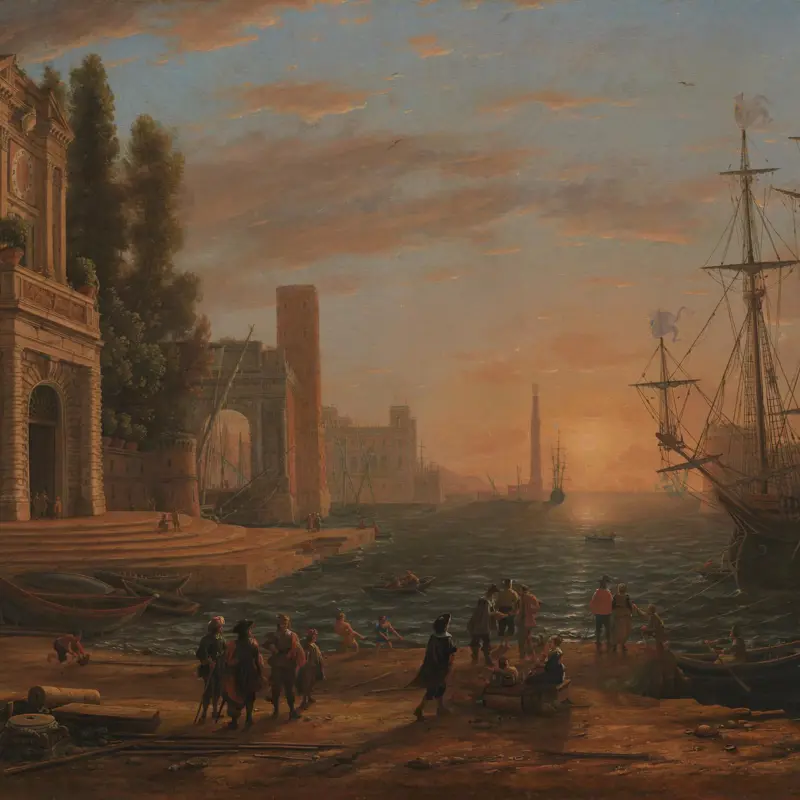Claude Gellée was born in the Duchy of Lorraine but left around 1612 for Germany, then Rome, where he became a studio assistant to the landscapist Agostino Tassi. He visited Naples and returned to Nancy before settling permanently in Rome around 1628. He sketched in the Roman countryside with Poussin. Ideas from the drawings he made were integrated into oil paintings finished in the studio.
Claude recorded his compositions in drawings, in the 'Liber Veritatis' (Book of Truth), now in the British Museum, perhaps to prevent pastiches being sold. Scottish and English aristocrats on the 18th-century Grand Tour bought many of his works; a number in the Collection come from such sources.
Claude was influenced by other northern painters who had worked in Rome, such as Elsheimer. He was also influenced by the Bolognese artists Annibale Carracci and Domenichino, who evolved the balanced classical landscapes he used.
In his turn Claude exerted considerable influence on landscape artists of the 18th and 19th centuries, as these examples show. The English painter Turner was especially indebted to Claude, and tried to outdo his grand compositions. In the Turner Bequest he directed that two of his works should hang with two of Claude's in the Gallery.
Claude
1604/5? - 1682
Works by Claude
(Showing 6 of 13 works)
This warm, tranquil port scene is bathed in sunlight: the clock on the building to the left records the time as five o'clock. A coat of arms with three golden fleurs-de-lis (emblem of the French king) above the clock and on the ship’s flags to the right suggests this painting was intended for a F...
This painting combines a view of Rome, on the left, with an imaginary ruin, on the right. The distant view is of the sixteenth-century church of Santa Trinità de' Monti, where Claude would be buried. Beside this is the convent of the Sacro Cuore. These buildings are now at the top of the Spanish...
This small painting beautifully evokes the lushness of the natural world. A young man rests against the base of a tree and turns his head towards us. He holds one hand to his mouth as if playing a flute just out of view, a pose derived from images of the classical hero Orpheus charming the animal...
Aeneas, prince of Troy, dressed here in an orange cloak, left his native city and arrived with his father, son, and companions on the island of Delos, home of the sun god Apollo. Anius, the King of Delos, dressed in white, gestures to an olive and palm in the centre of the painting, two trees sac...
Not on display
Diana, goddess of hunting, stands between the huntsman Cephalus and his wife Procris. Procris gives her husband a spear, carried here by an attendant, and a magic dog. The painting is loosely based on a story in Ovid’s Metamorphoses. The title suggests that the pair are being reunited after a fal...
King David and his companions emerge from the cave of Adullam. They cannot enter the city of Bethlehem and the valley below as the Philistines, whose pitched tents are just visible in the bottom left corner, occupy both. Nevertheless, three of the King’s soldiers have bravely ventured out to fulf...
Not on display
Claude illustrates the Old Testament story of Hagar, setting it in a tranquil landscape bathed in hazy sunlight. Hagar is an Egyptian servant girl who gives birth to Abraham’s child and runs away after quarrelling with Abraham’s childless wife, Sarah. Claude captures Hagar’s suffering and despair...
Claude takes the subject of this painting from Ovid’s Metamorphoses. The nymph Echo is in love with the beautiful youth Narcissus, who rejects her. In Claude’s painting, the goddess Nemesis punishes Narcissus by making him fall in love with his own reflection in a pool of water.The castle in the...
Not on display
According to the legend, Saint Ursula, a Christian princess from Britain or Brittany, made a holy pilgrimage to Rome with 11,000 virgins. Dressed in yellow and holding a flag with a red cross, Ursula watches her companions embark on their return voyage. They carry bows and arrows, weapons that re...
This painting depicts an episode from the Old Testament: the Queen of Sheba embarking on her journey to see King Solomon in Jerusalem. Crowned and dressed in red, the Queen descends the steps. The meeting was often painted, but it was unusual to depict the Queen’s embarkation. The soft warm light...
Threatened with marriage to a monster Psyche, a mortal, is blown away by the West Wind. She awakens near a magical palace and falls in love with Cupid. He makes Psyche promise not to look at his divine face, but she breaks this promise and Cupid abandons her. The subject of this painting is taken...
According to an inscription on a tree stump in the centre, this painting shows the marriage of Isaac and Rebecca described in the Old Testament book of Genesis. The couple dance with tambourines, surrounded by other figures reclining and enjoying the festivities. The flat landscape and expanse of...
Studio of Claude
Taken from an episode in Ovid’s Metamorphosis, this painting shows the moment when Cephalus is horrified to find his wife Procris impaled and slumped against a tree, after he has accidentally killed her with his spear. He thought she was a wild animal – the deer fleeing over the horizon was his i...
Not on display
You've viewed 6 of 13 works













